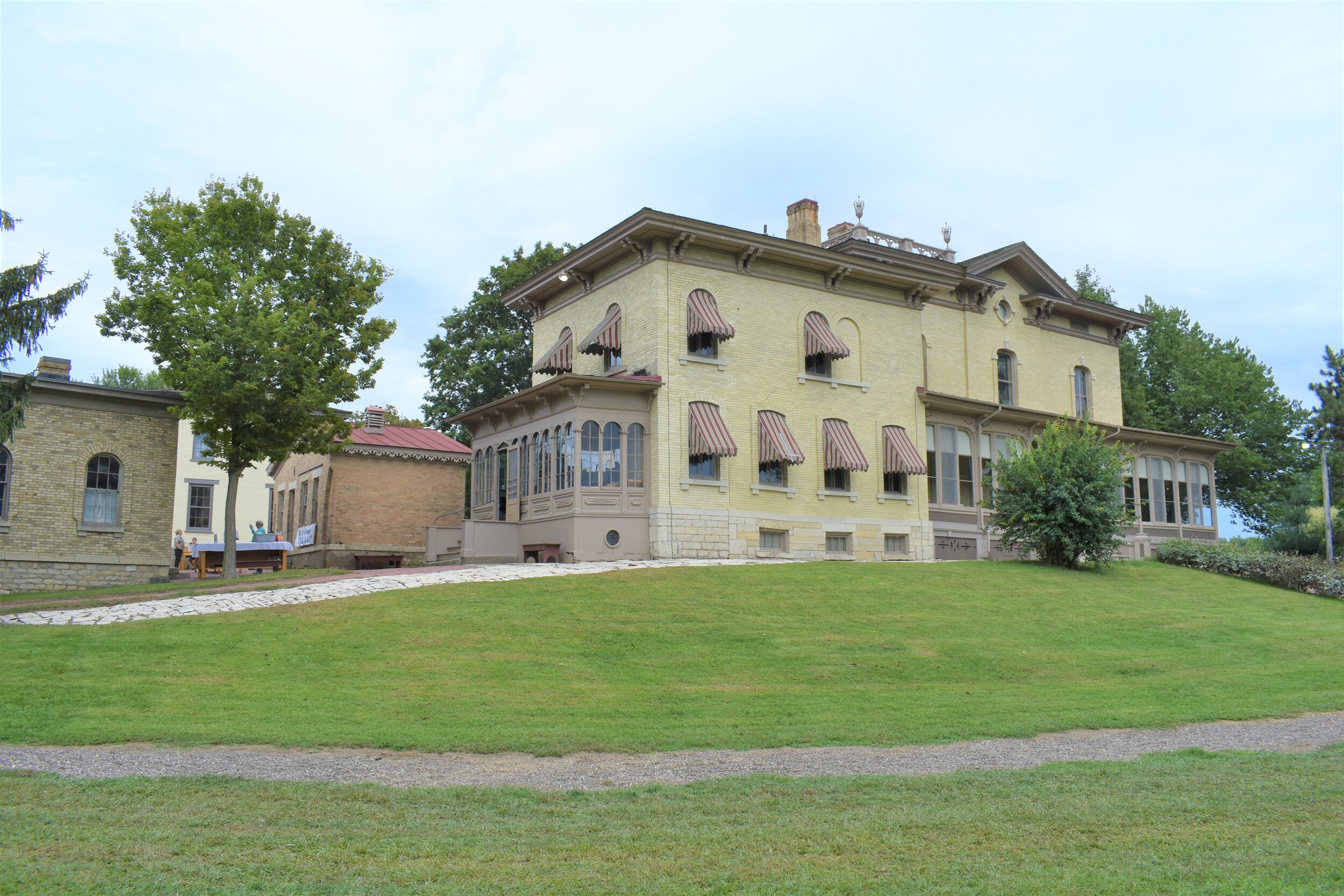Indian mounds at Prairie du Chien
WHEN I STUBBED MY TOE on the discovery that Fort Crawford in Prairie du Chien, the second oldest settlement community in Wisconsin located smack dab in the heart of the driftless area, was originally built atop an ancient Indian mound, I had to pinch my frybread and re-adjust my Eagle bustles just to make sure I wasn’t dreaming.
Around the turn of the century, I had developed a sharp interest in Wisconsin’s ubiquitous Indian mounds. A friend and I had been hired to clean out a garage for a relative who had, at that time, recently walked on and we were informed that we could keep any items from his storage for ourselves, a gesture not uncommon amongst the “noble red man of the wooden lot (Mark Twain)”. I had opted for a book titled “Indian Mounds of Wisconsin”, by Robert A. Birmingham and Amy L. Rosebrough. Thus, began a personal love for Wisconsin’s vibrant indigenous heritage, as far as ancient earthworks are concerned.
My passion for historic earthworks is buoyed by my current virtual tour of Wisconsin’s Driftless Area. While a resident at the veteran’s home in King, Wisconsin, during a recent personal sabbatical, I began writing for DriftlessNow.com.
I had at that time developed a writing campaign strategy to accomplish the mission purposed. I decided to map out a tour of the Driftless Area, starting at Prairie du Chien. This strategy would highlight a multitude of point-of-destinations in Wisconsin’s Driftless Area. That’s when I discovered that the original Fort Crawford on the island of St. Feriole in the Prairie du Chien area was actually built on an ancient Indian mound. My heart dropped at the very prospect of such a desecration of our collective Wisconsinite history and also of the seemingly coincidental nature of the mound being located at my virtual tour starting point.
During the 19th century not much was known about ancient indigenous earthworks in the Upper Midwest, let alone the people who built them (just because the mounds were built on Indian land does that necessarily mean that the people who built them where Indians? There wasn’t even such a thing as ‘Indians’ back in the days when the mounds were built. As far as that goes, just exactly what is an Indian anyways? Possibly just another label beginning with the capital letter “I” meant to subjugate the oppressed?).
In the 19th century it was commonly believed that these ancient mounds were used for military applications, burial sites, and ceremonial platforms. When I further researched the subject matter, I found myself in a situation where it was near impossible to quote a source concerning the mound at St. Feriole.
Its existence is not on record with the Wisconsin Historical Society. Further research turns up not a trace of said mound; save for that of the Prairie du Chien Area Chamber of Commerce, Inc.
In their section on the history of Prairie du Chien, the Chamber of Commerce writes, “In 1816 Fort Crawford was built on the Indian mound now occupied by the Villa Louis. Hercules Dousman brought the American influence to the fur trade. His (Hercules Dousman) impact on the territory and Prairie du Chien is hard to overestimate. In 1825, 1829, and 1830, important treaties were signed with the area tribes at Fort Crawford. During the winters of 1829 and 1830 important treaties were signed with the area tribes at Fort Crawford. During the winters of 1829 and 1830, Army surgeon Dr. William Beaumont conducted experiments that are still the basis of understanding the digestive process. A series of bad floods in the 1820s destroyed the wooden fort leaving it uninhabitable.”
This reality might lend a clue as to the fate of the ancient Indian mound. It may very well have been destroyed by the United States War Department in order to build a fort that was meant to rid the land of the indigenous population occupying the area at that time.
At the time of publication, the Prairie du Chien Area Chamber of Commerce, Inc. was unavailable for comment. Closed due to the COVID-19 pandemic.
Also unavailable for comment is the Fort Crawford Museum.
According to some Indian mound enthusiasts, Fort Crawford was an outpost of the United States Army. There were actually two forts built on the same location. The first one saw the light of day from 1816 to 1832. The second one from 1832 to 1856.
The Army established a presence in the Prairie du Chien area during the massacre of Black Hawk and his homeless followers during the Battle of Bad Axe on August 1-2, in 1832. Interesting to note, here, is that the original Fort Crawford was built on the ruins of British Fort McKay that was actually Fort Shelby captured from the Americans during a tumultuous time when that mound was actually situated on Indian land right from the beginning. When the British finally vacated the area, they burned the fort to the ground, because that’s just the type of bayonet packing people they were.
An entry in Wikipedia states: “To protect Prairie du Chien against future invasion, US forces returned in June 1816, with orders to construct a new fort on the site of Fort McKay. This fort was named Fort Crawford in honor of William H. Crawford, the Secretary of War under James Madison.”
The Wikipedia entry continues thusly: “Following the completion of Fort Crawford, the garrison was engaged primarily in peacekeeping between the new white settlers arriving in the region and the region’s historic Native American tribes...The United States conducted several negotiations with American Indians at Fort Crawford during the 1820s. One of the largest Indian councils in US history was held at the fort in 1825, when over 5000 representatives of nearly a dozen Native American nations gathered to discuss and sign the first Treaty of Prairie du Chien.”
In 1826 the fort was left to rot.
The second Fort Crawford was constructed on the mainland of Prairie du Chien; completion date: 1832. It was later abandoned in 1848 but reoccupied in 1855 because of rumors of Indian uprisings on the horizon. Nothing became of that and so the US military abandoned the fort for the last time in 1856.
Subsequently in 1933, Daughters of the American Revolution gave the fort’s hospital a facelift. Then, in the ‘60s the facelift became a museum for the Wisconsin Medical Society and it was operated by the medical society until 1955. A year later the property was gifted to the Prairie du Chien Historical Society.
Meanwhile, back to the house on the Mound… attempts were made to contact Villa Louis at the time of this writing to get a little background history concerning the estate, however, Villa Louis was closed for the season.
Enter center stage: Wikipedia. “The estate now known as Villa Louis began when Prairie du Chien trader and investor Hercules Dousman purchased land previously occupied by Fort Crawford. Dousman had the remains of the fort cleared away. In 1843, he built a large, brick Greek Revival house atop an Indian mound, which had been the site of the old fort’s southeastern blockhouse. Because of this, Hercules Dousman’s home has come to be called the “House on the Mound”. This name was also used as the title of an August Derleth novel that featured Dousman as a principal character. Hercules Dousman lived in the House on the Mound until his death in 1868. At the time of his death, he was one of the wealthiest men in Wisconsin, and his fortune passed to his wife Jane and his son Louis...Upon coming into his father’s estate, Louis decided to demolish the House on the Mound and replace it with a more contemporary Victorian Italianate style house that included modern indoor plumbing and central heating, both considered luxuries at the time.”
Should you happen to be in the vicinity of the House on the Mound, check out these upcoming events:
* Feb 27 - (Virtual Program) Prairie du Chien Bald Eagle Day
*Click to view dates- Music in the Wine Garden at Eagles Landing Winery











